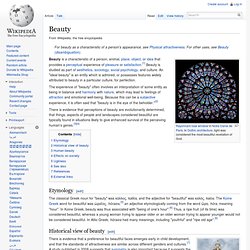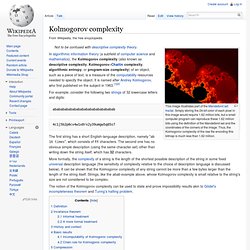

THEORY OF BEAUTY - FACIAL ATTRACTIVENESS - LOW-COMPLEXITY ART. Word-sense disambiguation. Current accuracy is difficult to state without a host of caveats.

In English, accuracy at the coarse-grained (homograph) level is routinely above 90%, with some methods on particular homographs achieving over 96%. On finer-grained sense distinctions, top accuracies from 59.1% to 69.0% have been reported in recent evaluation exercises (SemEval-2007, Senseval-2), where the baseline accuracy of the simplest possible algorithm of always choosing the most frequent sense was 51.4% and 57%, respectively. About[edit] A disambiguation process requires two strict things: a dictionary to specify the senses which are to be disambiguated and a corpus of language data to be disambiguated (in some methods, a training corpus of language examples is also required).
WSD task has two variants: "lexical sample" and "all words" task. A type of fishtones of low frequency and the sentences: I went fishing for some sea bass.The bass line of the song is too weak. History[edit] Difficulties[edit] Common sense[edit] Beauty. The experience of "beauty" often involves an interpretation of some entity as being in balance and harmony with nature, which may lead to feelings of attraction and emotional well-being.

Because this can be a subjective experience, it is often said that "beauty is in the eye of the beholder. "[2] There is evidence that perceptions of beauty are evolutionarily determined, that things, aspects of people and landscapes considered beautiful are typically found in situations likely to give enhanced survival of the perceiving human's genes.[3][4] Etymology[edit] The classical Greek noun for "beauty" was κάλλος, kallos, and the adjective for "beautiful" was καλός, kalos.
Historical view of beauty[edit] Florence Cathedral and dome. Plato considered beauty to be the Idea (Form) above all other Ideas.[10] Aristotle saw a relationship between the beautiful (to kalon) and virtue, arguing that "Virtue aims at the beautiful Beauty is truth, truth beauty, —that is all. Human beauty[edit] St. Ugliness[edit] Kolmogorov complexity. In algorithmic information theory (a subfield of computer science and mathematics), the Kolmogorov complexity (also known as descriptive complexity, Kolmogorov–Chaitin complexity, algorithmic entropy, or program-size complexity) of an object, such as a piece of text, is a measure of the computability resources needed to specify the object.

It is named after Andrey Kolmogorov, who first published on the subject in 1963.[1][2] abababababababababababababababab 4c1j5b2p0cv4w1x8rx2y39umgw5q85s7 The first string has a short English-language description, namely "ab 16 times", which consists of 11 characters. The second one has no obvious simple description (using the same character set) other than writing down the string itself, which has 32 characters. The notion of the Kolmogorov complexity can be used to state and prove impossibility results akin to Gödel's incompleteness theorem and Turing's halting problem. Definition[edit] Any string s has at least one description, namely the program: ∀s. ∀s. Aesthetics. More specific aesthetic theory, often with practical implications, relating to a particular branch of the arts is divided into areas of aesthetics such as art theory, literary theory, film theory and music theory.

An example from art theory is aesthetic theory as a set of principles underlying the work of a particular artist or artistic movement: such as the Cubist aesthetic.[6] Etymology[edit] The word aesthetic is derived from the Greek αἰσθητικός (aisthetikos, meaning "esthetic, sensitive, sentient"), which in turn was derived from αἰσθάνομαι (aisthanomai, meaning "I perceive, feel, sense").[7] The term "aesthetics" was appropriated and coined with new meaning in the German form Æsthetik (modern spelling Ästhetik) by Alexander Baumgarten in 1735. History of aesthetics[edit] Any aesthetic doctrines that guided the production and interpretation of prehistoric art are mostly unknown. Ancient Greek aesthetics[edit] Indian aesthetics[edit] Chinese aesthetics[edit]